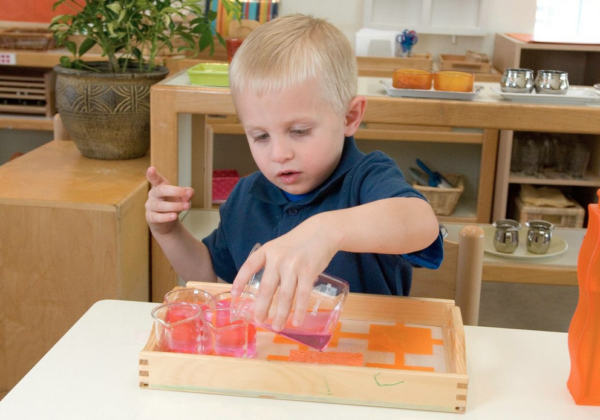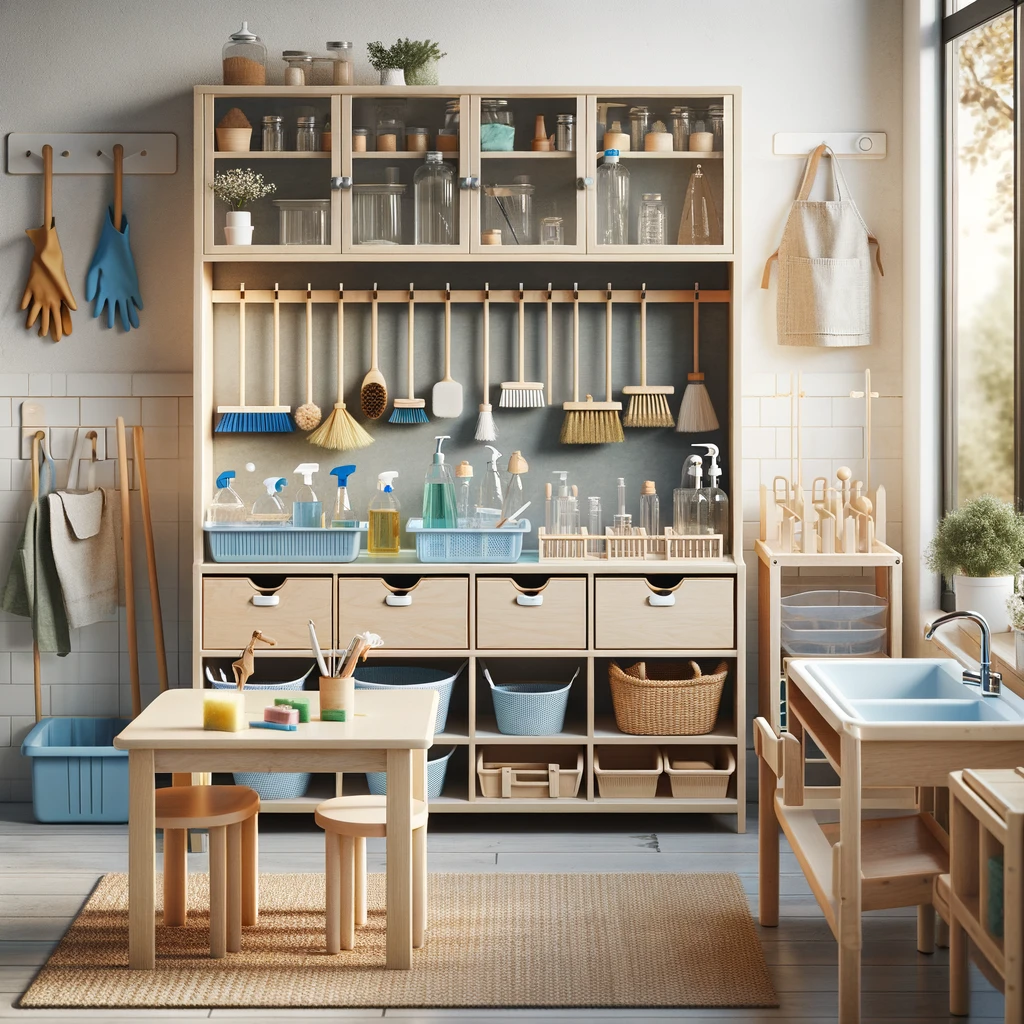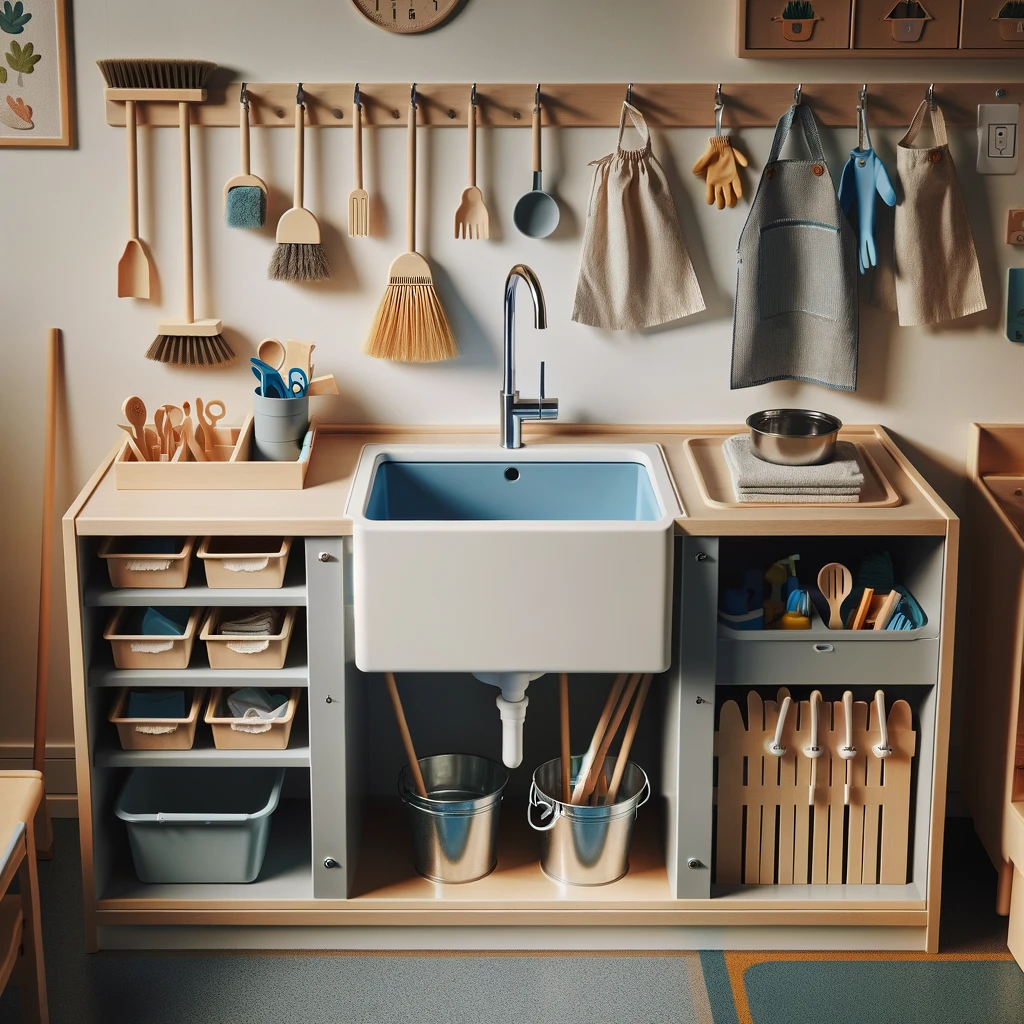The Purpose Of Practical Life In Montessori is simply unique. Imagine it as teaching youngsters the superpowers they want for daily life. These activities are like building blocks. They help youngsters learn how to cope with themselves and their surroundings. For example, they practice buttoning their personal shirts, pouring water with out spilling, or sweeping the ground. It’s no longer just about the duties themselves. It’s also about supporting youngsters become greater independent, confident, and accountable. They learn to resolve their very own problems and assist others too. Practical Life is all approximately making kids feel successful and important of their international.
The child can only develop by means of experience in his environment. We call such experience work.
The following points should be kept in mind while conducting EPL at home or in the classroom.
Choosing Activities of Purpose Of Practical Life In Montessori
1.While choosing cleaners , good quality mild and non – toxic be selected which are in no way harmful for the child . cleaners which are sprayed must be avoided because there remains a chance for it to be breathed in which can be harmful. For similar reason, the use of spray paint must be abstained .Only best cleaners must be provided.
2.Good quality tools, sponges, utensils and clothes should be used Purpose Of Practical Life In Montessori .
3.All tools like brushes, knives etc. must be child sized and should not be toys. All tools must function well.
4.All cleaning tools must be kept clean and washed regularly.
5.The number of tools does not exceed the basic minimum which means that there should not be too many to choose from; whenever things increase in number it becomes difficult to keep them in order .
6.EPL must be done in a realistic manner like the child sees it being done in his house. Some modern Montessori schools have sinks built in the classroom and just like any house where cleaners and kitchen ware is kept near the sink area, brooms and brushes can be kept in the cupboard built under the sink .
Gloves and aprons are hung at places within the child’s reach. Utensils are kept in drawers with partitions. Some material for basic exercises is placed ready in a tray on the table, but the rest of the things should be stored away as in a regular home .All this facilities children mastering EPL.
7.Whenever an activity is to be done, the teacher collects the material from the cupboard and shows the child how to select it. After finishing the exercise the teacher helps the child put the material back in an orderly way.
8.Whenever the child wishes to practice any EPL activity, he will need to remember which material or cleaners were used and he must select them from among the other materials ,tools and cleaners. The child while doing all these activities behave in an intelligent manner. the way adults behave in their house. 
Setting Up
1. The EPL must have all things like hooks , aprons, sweeping kit and dusters. All this should be within easy access of the child.
2.The EPL area should be located near the sink as there are certain activities in which water is needed.
3.In setting up a classroom, always select furniture with different surfaces so that the child can practice cleaning various kinds of surfaces like painted, varnished , unvarnished and Formica table tops. Similarly objects of brass and silver can be used in the classroom for different purposes ,at the same time can be polished and the children can clearly see their purpose as well as do the activity with them.
4. Children must also get to wash different kinds of clothes like apron, duster ,towel etc. Which are made of different fabrics so that you can get the experience of washing multi textured fabrics .
5. Whenever an activity dealing with liquids is performed, the teacher and the child must wear plastic aprons, and roll up their sleeves.
6.For cooking exercise a clean cloth apron should be worn.
7.While working near the sink, the child is to be shown to stand a little away from the sink or the table so that the abdomen does not touch the wet surface and the apron does not become wet. At the end of the activity the cold must be encouraged to clean up any spills. The child is shown how to place the material back after rising, washing and drying that it needs, and how to hang the apron.
Note ; cleaning any mess should be encouraged cheerfully and not forced by the teacher.
8.Young children have a natural urge to like order, so the rule “there for everything , and everything has a place” must be observed .With the help of this rule , at the end of the day everything is quite clean and is order, even with very active and intelligent children . Most of us would think that this is hard to maintain, however , in a true Montessori it is possible . The children of this age like order as well . Children make a huge effort to remember the exact place of things, to take them from there, and return them to their proper place. This effort to memorize each place for the child .
9.The child must be aware of any thing missing from its place. But if there are too many objects in the environment , they will have greater confusion in remembering the places of all of them . Therefore, it is wise to keep the things to a basic minimum; too much choice does not make the children work well, so it is better to keep all material, which is used rarely, out of the class in a cupboard .
The child should observe the environment and learn where each thing belongs. The teacher must not make them remember the place of a particular material with the help of name tags or any color coding system . This process does not make the child observe the environment intelligently, rather the child acts in the way the adult wants him to …placing the material accurately and remembering and matching the tags. This way the real work of observing is left behind .
Presenting Activities guidelines
1.When a child is admitted to a Montessori school by the age of three years, EPL should be taught to him stepwise with accuracy and intelligence. The child moves from easier to complex. Many times complex activities are broken down into many simple activities .Along with that, skill acquired while mastering one activity also helps the child perform related next ones easily. Each step an activity must be done with skill and clarity so that the child practices each step, gains perfection, and then moves on to the next steps.
2.The directress must also know the right way to perform it .She, firstly, demonstrates and then allows the child to do it himself for as long as he likes. Each activity done must be done in a happy and enjoyable manner because the child will not like to learn any activity which is disliked by the adult .
3. While doing any activity the child imitates the adult closely , we must always enjoy what we are doing before the children.
4.At this point, nature is guiding the child to act, imitate and learn all work which is done by adults so that gradually he walks the path to become independent.
5.While using cleaners the teacher must first read the instructions on the bottle, bringing to the notice of the child that the ones written in red are the most important.
6.Before each presentation a lot with the material yourself . The more you practice, the more familiar and flexible you become with the material and this gives you more command to do the exercise in a better and efficient way.
7.The teacher should demonstrate the activity without using any language because children can concentrate better on one thing at a time, i.e. the actions performed in the activity. The child will become confused if the teacher combines the demonstrations with language.
8.Always give lessons in a relaxed, cheerful and gentle way.
9.Keep the lesson brief and easy. Show the children how to do the exercise using only the necessary movements and as few words as possible.
10.Take the child’s consent and brief him about what you are going to present. Also bring the material to work place with the help of the child.
11.Perform the activity, When the activity is complete, place the material back with the help of the child.
12.After the activity , instruct the child to use the material whenever she likes.
13.While using tools which might be dangerous, make the child aware of the blunt and sharp side of the knife etc. and how to handle it .
14.While doing exercise where instructions are written . read the instructions aloud with the children.
15.Keep observing the children , and ask yourself questions like;
.Is the activity needed to be made simpler?
. Which activities interest the children more ?
.Is the environment needed to be changed ?
. Are the materials being used in constructive and useful ways ?
. Do they facilitate the development of a skill ?
. Are they realistic ?
. Are they purposeful ?
. Do they lead to independence , personal and social responsibility and development of self esteem through increased competence ?
16.The activities which are no longer being used by the children should be put away.
17. Observe if the material is being used by the child in the correct way. Keep making mental notes . If some presentation needs to be given again, repeat the lesson .
18.Always expect that the children might need more than one demonstration from time to time .
19.The teacher must not interrupt the child if he is doing something incorrectly , rather, the demonstration should be given again at a neutral time . In this way the self esteem of the child is left unharmed because interrupting the child would mean to let him down. Secondly we deprive him of a chance to discover himself through trial and error.
20. Always show appreciation at the handling amount of contribution involved during performing even the easiest of activities which the child does, because he achieves all this with a lot of concentration. Never interrupt him .The child performs an action again and again keeping in mind that he is acquiring a skill, not just getting done with the activity.
Conclusion
The Purpose Of Practical Life In Montessori component in Montessori education plays a crucial function in kid’s improvement, presenting them a completely unique street to gain the essential capabilities necessary for navigating each day existence with confidence and independence. Through conducting normal tasks like buttoning shirts, pouring water, and sweeping, kids no longer most effective research realistic skills but also broaden a experience of duty, hassle-solving skills, and a strong vanity.
These activities are designed to mimic real-lifestyles eventualities, making studying relatable and meaningful. The emphasis on the usage of actual, first-rate tools and materials in addition enriches this enjoy, allowing children to interact with their environment in a constructive and academic manner. By fostering independence and imparting possibilities to make a contribution to their network, Practical Life sports help form nicely-rounded, successful individuals who are organized to stand the Purpose Of Practical Life In Montessori demanding situations of the larger world.
FAQ’s
1. Why are Practical Life activities important in Montessori education?
Purpose Of Practical Life In Montessori sports are essential as they help youngsters increase excellent motor abilities, a sense of order, attention, independence, and self-esteem. These skills are foundational for academic gaining knowledge of and for lifestyles in fashionable.
2. Can Practical Life sports be conducted at domestic?
Yes, many Practical Life sports can easily be tailored for the home environment. Parents can involve their youngsters in each day duties which include cooking, cleansing, and gardening, making sure the activities are age-suitable and safe.
3. How do I pick out the proper sports for my toddler?
Select Purpose Of Practical Life In Montessori which might be developmentally appropriate, secure, and of hobby on your baby. Use real gear and substances each time feasible, and ensure they may be toddler-sized to facilitate ease of use.
4. How can I ensure the protection of my child in the course of those sports?
Choose non-toxic, slight cleaners, and keep away from items that may be dangerous if inhaled, like spray paints. Ensure all tools and substances are toddler-friendly and safe to be used. Supervision is important, especially whilst kids are operating with doubtlessly dangerous gear.
5. How do Practical Life sports prepare kids for educational learning?
These sports expand attention, hand-eye coordination, and exceptional motor competencies, which might be crucial for tasks like writing. They also encourage a feel of obligation and independence, qualities that make contributions to a nice learning mind-set.
6. How can I set up a Practical Life location at domestic?
Create a devoted space with easily handy materials and gear. Include quite a few activities that cater to exclusive skills and pursuits, making sure the entirety has its region for smooth cleanup and order.
7. How can I encourage my infant to participate in Practical Life sports?
Demonstrate the sports your self in a completely satisfied and engaging manner. Allow your child to select sports that hobby them, and keep away from interrupting or correcting them unnecessarily. Praise their efforts and inspire independence.
8. What if my toddler makes a multitude or does not whole the venture perfectly?
Emphasize the manner Purpose Of Practical Life In Montessori over perfection. Encourage your baby to easy up messes cheerfully and notice errors as studying opportunities. The intention is to foster independence and trouble-fixing competencies, no longer to reap perfect execution.

1 thought on “Purpose Of Practical Life In Montessori: Activities Within the Montessori Method”